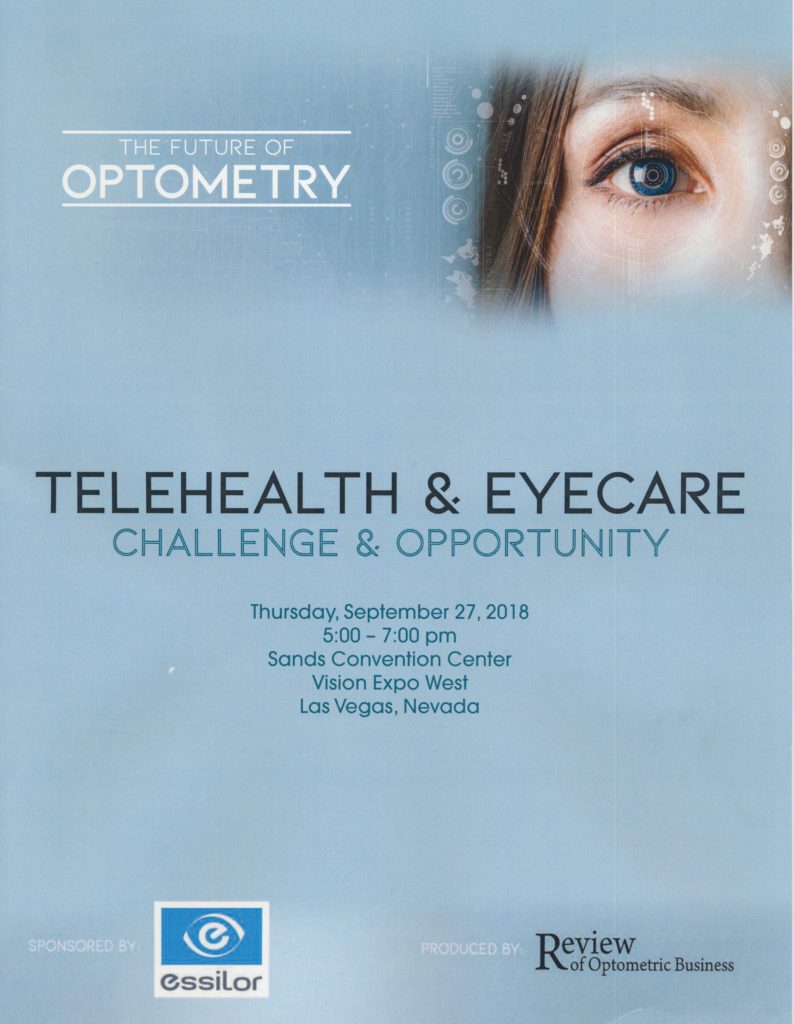By Margery Weinstein
Editor-in-Chief, ROB
Oct. 17, 2018
The goal of using telehealth to expand access to care and improve outcomes was explored at the Vision Expo West special presentation, “The Future of Optometry: Telehealth & Eyecare.”
>>Click HERE to download the brochure from this presentation>>
The special event, sponsored by Essilor, and produced by Review of Optometric Business, featured ROB Professional Editor Mark Wright, OD, FCOVD, and Larry Macapagal, OD, director of optometry, Southern California Permanente Medical Group, as presenters.
Panelists included: Linda Chous, OD, of The Glasses Menagerie and chief eyecare officer at UnitedHealthcare; David Geffen, OD, FAAO, director of optometric and refractive services at Gordon Schanzlin New Vision Institute TLC; and Tim Petito, OD, FAAO, of Petito Eyecare and director of professional relations for Marco Ophthalmics.
The panelists agreed that telehealth offered great opportunities to provide access to care, including providing on-demand answers to health questions, but cautioned that HIPAA compliance and patient safety would have to be fully addressed.

L-R, back row: ROB Professional Editor Mark Wright, OD, FCOVD, ROB Content Director Roger Mummert. L-R, front row: Linda Chous, OD, David Geffen, OD, FAAO, Larry Macapagal, OD, and Tim Petito, OD, FAAO.
Be Part of a Larger Wellness Team
“Optometry can quickly become part of the wellness team in a telehealth situation,” Dr. Wright said, noting that, at its best, telehealth enables efficiency to go up and cost to go down. He drew a comparison to the panic some in optometry felt when the auto-refractor was first introduced. Just as the auto-refractor has become a part of most practices’ overall care, telehealth can be used as a valuable piece of an overall patient care plan.
Dr. Wright said practices need to start right away planning how to integrate telehealth tools into the care they provide. “It’s not a question of when this comes; it’s here already,” he said.
Dr. Macapagal noted the strong preference Kaiser’s members have for telehealth options, and said that while doctors and practices plan how to best implement the technology from their own perspective, they shouldn’t forget the most important element—the patient’s perspective on how they would most like to receive care and interact with health-care providers. “If you build it, they will come,” he said of most patients’ eagerness to try telehealth tools.
Employers, who provide health-care coverage, are finding employees requesting telehealth options, Dr. Chous said. She pointed out that optometrists have the opportunity to become part of the remote care team for primary care providers, who may take retinal photos and have those photos sent elsewhere for analysis and diagnosis. An OD could become the eyecare provider whom that PCP sends the photos to for co-management. She said that telehealth, used in this way, could enable PCPs to have consultation rooms in which telehealth enables PCPs and co-managing doctors to “engage patients directly in their care.”
AI-Powered Telehealth Can Provide On-Demand Care
Dr. Macapagal shared a video in which simple telehealth communications with doctors are taken to the next level with artificial intelligence in which, for instance, a father who is concerned about a red mark on his daughter’s arm can take a smartphone photo of it, have his daughter blow into the phone to have her temperature taken, and then have the AI system determine it is an insect bite requiring hydrocortisone cream.
Boost the Perceived Value of Your Services
Dr. Geffen stressed the importance of using telehealth technology to enhance the perceived value of optometric care. He said we should think about how telehealth can improve the patient experience. “If we are not providing a perceived value of experience in our office, it won’t matter what technology is out there.” He noted the coming shortage of ophthalmologists, and said telehealth could make it easier for ODs to step into the coming void that shortage may create.
Use Only for Existing Patients & Stay HIPAA-Compliant
Dr. Geffen said that while the technology may not be appropriate for new patients, it could serve an important role in providing care for existing patients, especially for some follow-up care. He cautioned that, in the process of using telehealth to curb unnecessary in-person appointments, that doctors carefully observe HIPAA laws, such as not receiving, and responding to, patient communications on personal devices that are not HIPAA-compliant.
Think First of Patient Safety & Need for Thorough Information Gathering
Dr. Petito also cautioned doctors to think carefully about appropriate, and inappropriate, uses of the technology, and to prioritize patient safety. “All that data that travels around is digital data, and we’re analog beings,” he said, pointing out how frequently patients will use imprecise language to describe symptoms, which the doctor needs to drill down to clarify.
When the patient sends a message, or tells an AI system, that they “lost vision,” do they mean they went completely blind, or simply that their vision became blurry? Doctors have to be careful that they can still drill down sufficiently to determine the next step in care that is needed, whether that’s an in-person visit, or whether telehealth communications are enough. “We need to put guardrails in place to ensure patient safety and good outcomes,” Petito said.
The Future of Optometry is a series of special presentations, sponsored by Essilor and produced by Review of Optometric Business, that explores future growth opportunities and challenges.
Read more about the Future of Optometry:
Future of Optometry: Coming Practice Growth Opportunities
Future of Optometry: How Much Will Your Services Be In Demand?
Future of Optometry: Top Takeaways from AOA Presentation
The Future of Optometry: Which ODs Will Capture Medical Eyecare Needs?
Future of Optometry: 2 Upgrades You May Need to Make in Your Practice
Future of Optometry: How Is Your Role in Healthcare Delivery Changing?
The Future of Optometry: What Can We Expect in Demand for Our Services?
Defining the Future of Optometry: Key Takeaways from a Major New Resource
WEBINAR: The Future of Optometry
 Margery Weinstein is editor-in-chief of Review of Optometric Business. To contact her: mweinstein@jobson.com
Margery Weinstein is editor-in-chief of Review of Optometric Business. To contact her: mweinstein@jobson.com
























